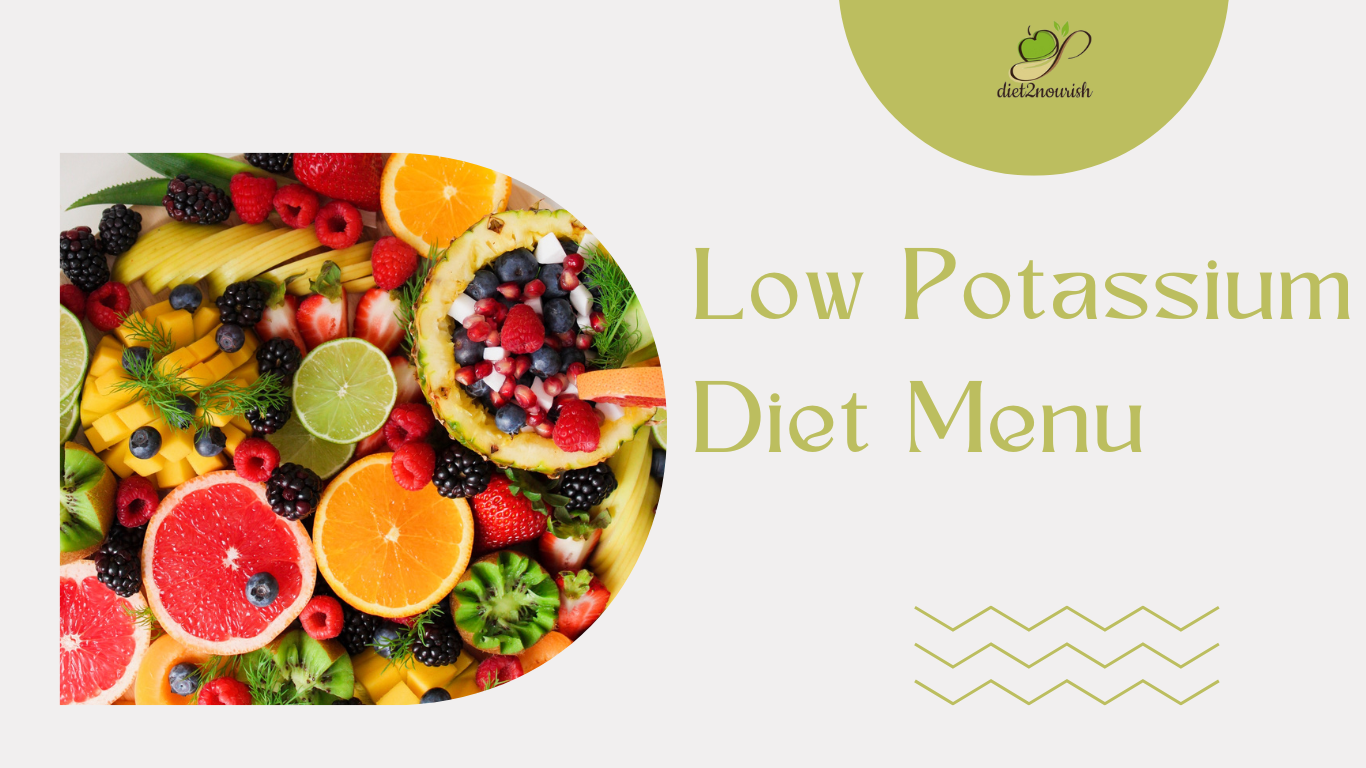Low Potassium Diet Menu
For any healthy person, a diet high in potassium can be very beneficial, as it helps reduce the chances of developing high BP, and kidney stones, experience lessen fatigue and more energy and helps in having better bone density. But there are many, it is best to be avoided them. Certain conditions need us to be on a low potassium diet menu, such as poor kidney functions, diminished adrenal functions, being on a diuretic that promotes potassium retention in the body, and low levels of renin/aldosterone.
Our kidneys are responsible to regulate the potassium and sodium in our blood, but as the kidneys stop working normally or begin to fail, it is unable to excrete enough potassium. It is therefore for such people; a low potassium diet menu is recommended to prevent the excessive build-up of potassium in the body.
What is a Low Potassium Diet?
Potassium is present in many of the foods we eat regularly from beans to lentils to vegetables and fruits. Potassium is an important mineral we all need for the proper functioning of the muscles, but too much potassium can be of potential danger to some. With a low potassium diet, we benefit from relatively low amounts of potassium in our blood which is very useful for maintaining normal heart and muscle functions.
A low potassium diet helps us avoid all and any risks that can arise from high levels of potassium in our blood like experiencing various symptoms of palpitations or irregular heartbeats, irritability, spasms, anxiety, slow and weak pulse, stomach cramps, excessive tiredness, diarrhea, and even heart failure.
How much Potassium is Safe?
If your measures potassium levels are:
- Between 3.5 to 5.0 you are safe.
- Between 5.1 to 6.0, you should be cautious.
- If higher than 6.0, you are in danger.
In general, women should consume 2600 mg and men should consume 3400 mg of potassium a day. But your needs might differ if you are suffering from kidney diseases. You should consume lesser potassium than normally specified. If your kidneys are at fault, excess potassium can stay in the blood causing nerve and muscular problems.
Low Potassium Foods for Kidney Patients
Potassium is one mineral that is in many common foods we eat. It is the job of our kidneys to maintain healthy levels of potassium in our bodies, but if our kidneys are not well or unhealthy, we will need to eat low potassium foods for kidney patients and restrict or avoid foods that can raise the levels of potassium in our bloodstream.
Low Potassium Vegetables :
The quantity of potassium in these low potassium vegetables can vary depending on several factors like the soil and the conditions in which they are grown. However, in most cases, the levels of potassium are considered safe, and you should always try to incorporate newer vegetables from the list above into your low potassium diet menu slowly and in smaller quantities. Most of these vegetables are low in calories, and you should eat them along with other low potassium foods.
Given below are some examples of low potassium vegetables:
● Broccoli:
Broccoli is a great source of fibre, vitamins, and minerals, and it’s low in potassium. Furthermore, one cup of cooked broccoli contains only 230 mg of potassium.
● Carrots:
Carrots are an excellent source of vitamin A, and they are also low in potassium. One medium carrot contains only 52 mg of potassium.
● Cauliflower:
Cauliflower is a low potassium vegetable. It is packed with fibre, vitamin C, and folate. Moreover, one cup of cooked cauliflower contains only 176 mg of potassium.
● Cucumber:
Cucumbers are a refreshing and low potassium vegetable. Moreover, cucumbers are also a great source of hydration. One medium cucumber contains only 147 mg of potassium.
● Lettuce:
Lettuce is a low potassium vegetable that’s also a great source of hydration. In addition to this, one cup of shredded lettuce contains only 10 mg of potassium.
Low Potassium Fruits
Similar to vegetables, fruits are also naturally low in potassium, however, some of the best low potassium fruits to have while on a low potassium diet menu are:
Apples, Blueberries, Cherries, Dried fruits (apples, blueberries, cherries, coconut, cranberries), Grapes, Lychee, Pear, Persimmon, Pineapple, Plum, Raspberries, Strawberries, Tangerines, and Watermelon.
Low Potassium Meats:
Here is a list of some low potassium meats:
- Chicken and turkey (skinless)
- Fish (cod, salmon, tuna)
- Beef and pork (lean cuts)
- Lamb
- Shellfish (crab, shrimp)
Potassium-Rich Foods to Avoid
Potassium is much needed by our body like sodium and calcium to keep us healthy. It is an electrolyte, which means it has smaller electrical charges that help activate our heart, kidneys, nerves, and muscles.
However, people with certain health conditions like kidney and heart diseases need to restrict or avoid eating foods that are high in potassium to ensure that excess potassium is not collected in their blood causing further health issues. Some of the potassium-rich foods to avoid while on a low potassium diet menu are:
Potatoes, Yams and sweet potatoes, Bananas, Yogurt and other dairy products, Legumes and beans like lentils, kidney beans, and lima beans, Oranges and orange juice, Winter squash, Spinach and leafy greens like Bok choy, beet greens, Swiss chard, and fennels, Salt and salt substitutes, Avocados, Tomato paste, Bamboo shoots, Chicken and meat, Clams and tuna, and certain Sports drinks.
How to Leach Potassium from Fruits and Vegetables?
Leeching is a process that helps pull out potassium from high-potassium vegetables before eating. The process of leeching is best if done for vegetables like potatoes, sweet potatoes, beets, carrots, and winter squash. The process involves:
- Peeling and placing the vegetables in cold water to avoid darkening.
- Then slice the vegetables thick.
- Rinse the vegetables in warm water for a few seconds.
- Soak the vegetables in warm water for a minimum of two hours. Use almost ten times the quantity of water. If you are soaking the vegetables for a long, make sure you change the water every four hours.
- Rinse the vegetables again under warm water for a few seconds.
- Finally, cook the vegetables with almost five times the water to the number of vegetables.
Always remember that the process of leeching vegetables will not pull out all the potassium from the leached vegetables. If you are on a strict low potassium diet menu, you should still limit the consumption of leeched high potassium vegetables. Always check with a reputed dietician for the amount of leeched vegetable that you can consume.
Snacks Low in Potassium
Renal patients have often been prescribed a low potassium diet menu. Consuming too much potassium with kidney problems can cause irregular heartbeats which can further lead to sudden heart failure. Here are some snacks low in potassium that you can always munch on in a low potassium diet menu.
- Popcorns: Air popper popcorns are low in potassium and fats. But, avoid popcorn popped with oil or butter.
- Chips and crackers: Chips and crackers are often low in potassium, but look for the ones that are low in fat too. Look for baked chips and crackers rather than fried ones.
- Dry cereals: Unsweetened – whole grain cereals are a great choice. Eat your cereals with dried berries. Avoid granola and bran cereals – they are too high in potassium.
- Fruits and vegetables: Fruits and vegetables are at any time the best low-fat, low-potassium snacking option. While, snacking on fruits, avoid the consumption of bananas, tomatoes, melons, and citrus fruits. These fruits are high in potassium. For veggiess, you must try lo-potassium veggies like cucumbers, radishes, broccoli, cauliflower, carrots, and corn.
Low Potassium Breakfast Foods:
Here is a description about a few low potassium foods that make a great breakfast option:
● Oatmeal:
Oatmeal is a versatile low potassium breakfast option. It can be cooked and topped with nuts and fruits. One cup of cooked oatmeal contains only 180 mg of potassium.
● Egg whites:
Egg whites are a great low potassium breakfast option that are high in protein. One egg white contains only 6 mg of potassium. Therefore, it can be consumed as boiled, scrambled or omelette forms.
● Pancakes:
Pancakes can be made with low potassium ingredients, such as flour, milk, and egg whites. Moreover, such pancakes are an amazing low potassium breakfast option.
● Smoothies:
Smoothies made with low potassium fruits, such as berries, and low potassium liquids, such as almond milk, can be a great low potassium breakfast option.
Frequently Asked Questions (FAQs)
If your potassium levels are high, you will need to keep them under the normal range to avoid health complications. You can do so by:
Following a low potassium diet menu.
Avoid consuming any salt substitutes.
Void opting for herbal remedies and supplements.
By taking water pills, also called potassium binders.
Carefully follow your diet and treatment plan as directed by your dietician and physician.
Here are some great ways to lower your blood potassium level:
Replace potatoes with other starchy foods like white rice, white bread, and pasta.
Consume more low potassium fruits like apples, grapes, and berries.
Drink more water than other fluids that may contain potassium.
Consume less coffee.
Drink other juices like cranberry juice other than orange juice.
Avoid consuming dishes with pumpkins.
Instead of eating sweet potatoes, yam, and winter squash, eat yellow squash and zucchini.
In place of dark greens like spinach, beet greens, and Swiss chard, try iceberg or romaine lettuce.
Many foods we consume regularly are high in potassium. Let’s look at these foods:
Fruits: Bananas, oranges, cantaloupe, honeydew, apricots, and grapefruit.
Fruit Juices: Orange juice, tomato juice, grapefruit juice, apricot juice, and prune juice.
Vegetables: Spinach and broccoli (cooked), sweet potatoes, potatoes, mushrooms, peas, pumpkins, zucchini, and leafy greens.
Beans and Legumes: Soybeans, kidney beans, lima beans, pinto beans, and all lentils.
Fishes: Tuna, halibut, trout, mackerel, and cod.
Other foods: Salt substitutes, meats, poultry, nuts, brown and wild rice, whole wheat bread, pasta, and bran and bran cereal.
High-sodium foods like canned soups, processed meats, and salty snacks should be avoided. This is because they can increase blood pressure and put a strain on the kidneys.
Processed foods, fast foods, fried foods and junk foods are loaded with unhealthy fats, and calories. High-potassium foods, such as bananas, oranges, tomatoes, and potatoes, can be harmful. Therefore, they must be avoided.
High-phosphorus foods, such as dairy products, nuts, and beans, can also be problematic for people with CKD. Therefore, the kidneys may not be able to remove excess phosphorus from the body.

